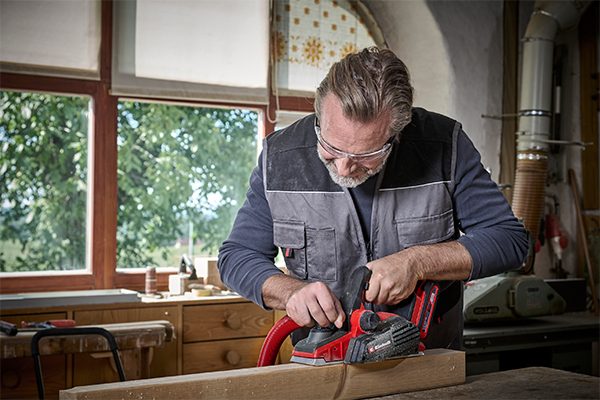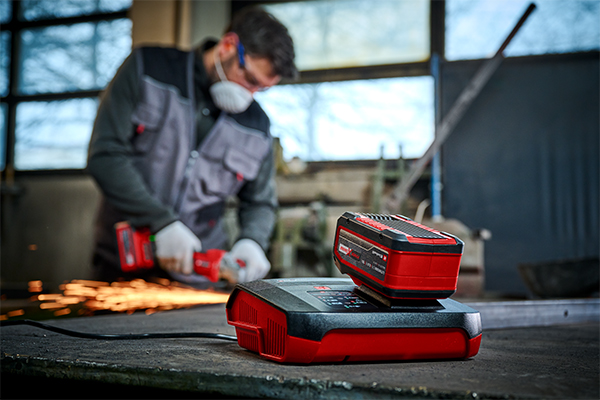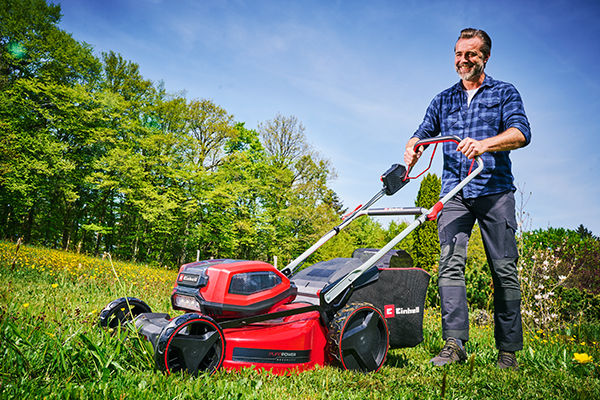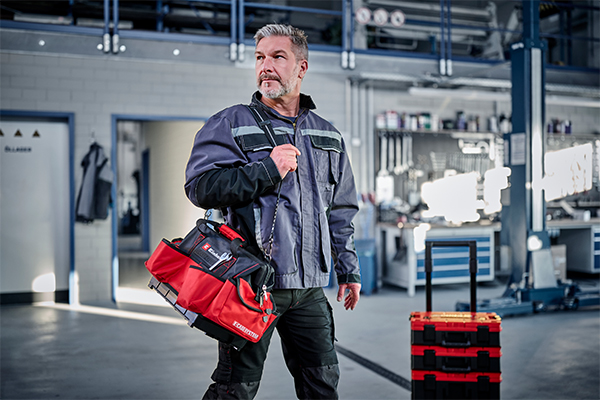Safety on the road: Everything you need to know about changing & storing tyres
When it comes to the safety and optimal performance of your vehicle, there's not much more important than making sure you have right tyres fitted at the right time. In Germany, we use the rule of thumb “from O to O”, i.e. from Easter (Ostern) to October, to remind us that summer tyres provide better grip and higher efficiency in the warmer months. Winter tyres, on the other hand, should be fitted between October and Easter to ensure the necessary grip on snow and slippery roads. In this article, you will learn not only how to carry out the tyre change step by step, but also how to properly store your tyres during the respective off-seasons when they are not in use. With our tips and tricks, you are guaranteed to be safe and comfortable on the road, no matter what time of year.
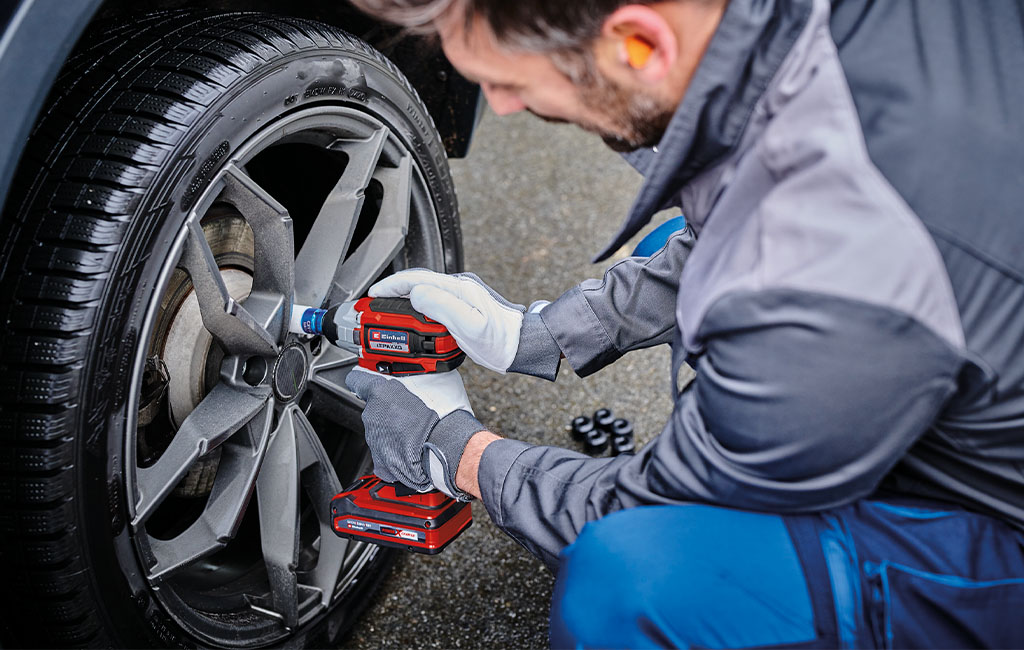
Why do tyres need to be changed?
Since 2010, motorists in Germany have been legally obliged to change their summer tyres and switch to winter tyres in accordance with the weather conditions. There is an important reason for this: the safety of the driver, as well as of other road users. That is why you should remember the following rule of thumb: from E to O. So, from Easter to October, you can use your summer tyres, or at least take these dates as a rough guide.
Summer vs. winter tyres
One tyre is the same as the next, isn't it? Unfortunately, it's not that simple. The two types of tyre differ significantly in one aspect: the rubber from which they are made.
- Summer tyres are made of a relatively hard rubber compound that, in conjunction with specially designed tread blocks, provides better overall performance. These tread profiles reduce the risk of aquaplaning and improve grip on both wet and dry roads. At low temperatures, the already hard rubber compound of the tyres hardens even faster and starts to become brittle. These tyres are specifically designed for optimal performance at warm-to-high temperatures. In addition, summer tyres have lower rolling resistance, which means that your car consumes less fuel.
- Winter tyres have a higher proportion of natural rubber and therefore remain supple throughout the winter, even in the cold. This ensures that the car tyre grips the tarmac better. Tyres for the cold season are marked with "M+S" or the Alpine symbol (a mountain with snowflake). They have a particularly deep and wide tread pattern, which allows them to take up a lot of snow. Snow sticks best to – yes, really – snow, and thus the wide tyre channels improve grip. Features called "sipes" also assist the tyre and the vehicle when driving in snow or on slushy and icy roads by biting into the surface below. These sipes also channel away water and prevent aquaplaning.
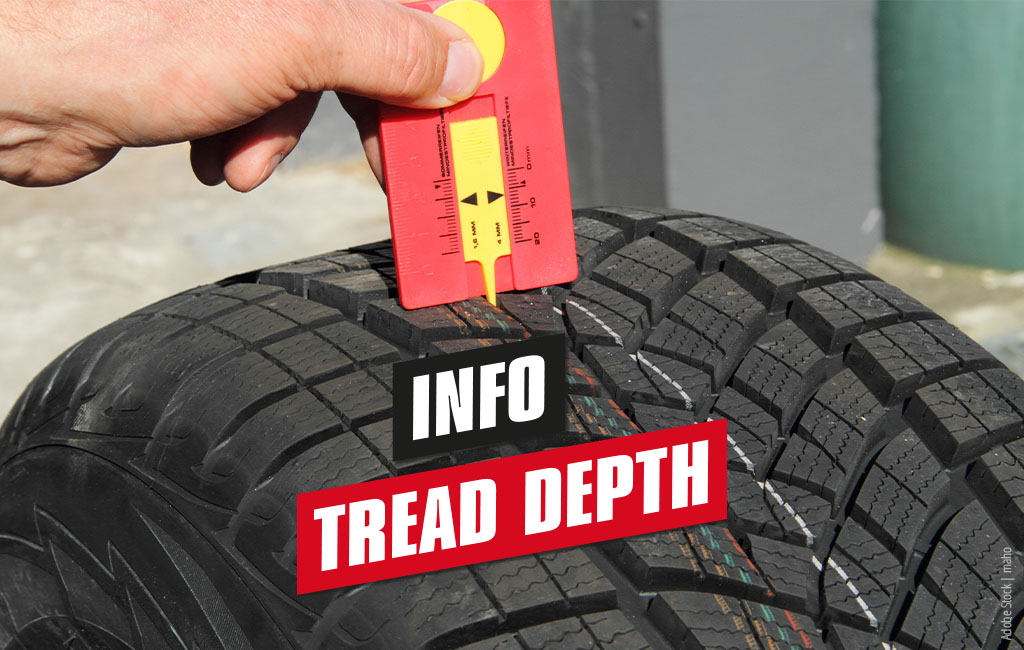
INFO: Tread depth
German legislation stipulates that wheels must have a tread depth of no less than 1.6 mm, both for summer and for winter. Otherwise, you could face a hefty fine and points on your licence. However, at least 3 mm is recommended for summer tyres and 4 mm for winter tyres. So make sure your tyres have a deep enough tread before you bolt them onto your car. This will keep you safe while driving.
Can I drive on winter tyres in the summer?
In theory, you can also drive on winter tyres in summer. In practice, however, this is not a good idea. From a legal standpoint, you are allowed to leave your winter tyres on your car through the summer months, so there's no risk of being fined. So it can be very tempting to save yourself the hassle of changing tyres and just keep on driving. In particular, if your winter tyres have less than 4 mm of tread depth and are no longer suitable for winter, it may even be worthwhile for cost reasons to continue using them as long as you can. However, winter tyres show weaknesses at high temperatures, which you can avoid by switching to a suitable summer tyre. A warm Alpine tyre has little grip on a hot, dry roadway, which results in longer braking distances. For this reason, it is definitely recommended to change tyres with the seasons.
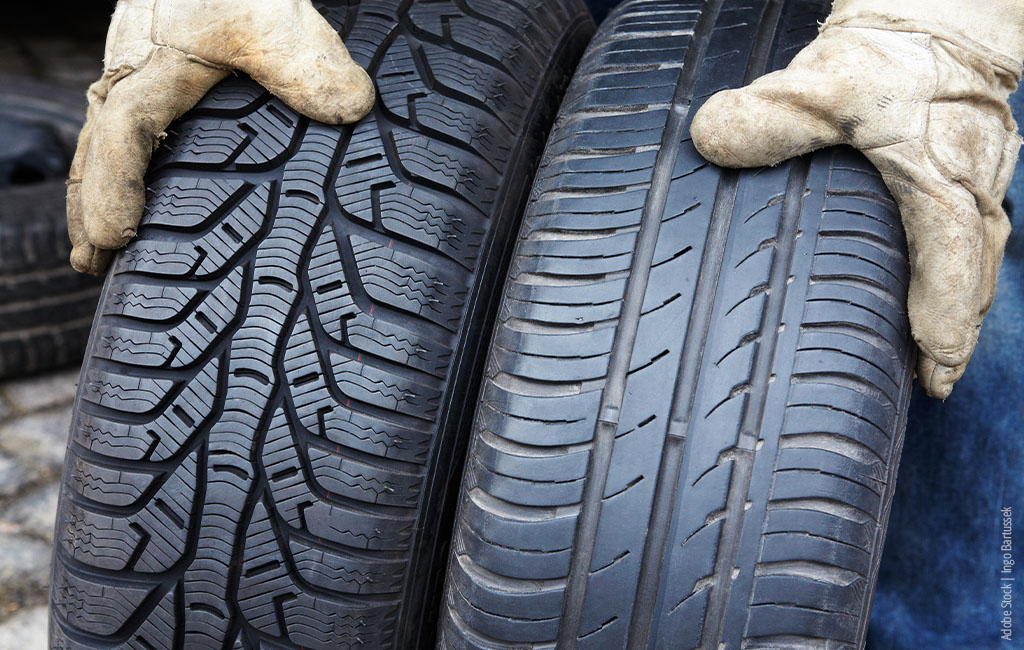
When should you change your tyres
As we have already mentioned, you should always make sure your car has the right tyres for the time of year. The rule of thumb is "from E to O". Winter tyres should therefore be installed on your car from October to Easter, and summer tyres from Easter to October. However, this is only a rough guide to give you a general idea. After all, weather conditions mean you can't always equip your vehicle with summer tyres at Easter. If there is still snow or overnight frost which leaves the roads icy, you should keep using your winter tyres for longer.
Are all-season tyres a good alternative?
If changing tyres is too time-consuming and expensive for you, there is an alternative: the all-season tyre. You can drive these tyres all year round – on hot tarmac and slushy roads alike. Sounds too good to be true? We show you the pros and cons:
Pros
- no twice-yearly tyre changes
- no need to purchase separate winter and summer tyres
- no problems with storage
- solid performance in all weathers
- saving time and money
Cons
- poorer handling in extreme weather conditions
- higher/faster wear due to use all year round
- should be replaced annually for safety reasons
In short: if you drive a low-power car in a big city, i.e. predominantly short distances in urban traffic, a year-round tyre can be worthwhile for you. If you drive a sporty model packing a lot of horsepower and you value good cornering dynamics and optimal grip, you should definitely opt for two sets of wheels.

Step-by-Step Instructions for Changing Tyres
The actual process of changing the tyres is not really that difficult. You just have to know the right order to follow to avoid injuring yourself or damaging the vehicle. However, before you start the process, it is important to check whether your seasonal tyre still has enough tread depth. Otherwise, you should invest in new wheels before starting to change your tyres. To help you keep on track the next time you change your tyres, we have summarised the most important steps for you. Of course, you should also get the right tools together beforehand, such as a jack, a spider wrench, an impact wrench or torque wrench, gloves, and a compressor to measure the air pressure (tyre pressure) and add more air if necessary.
Step 1: Raise the car
Drive your car onto a level surface, apply the handbrake and engage first gear. If you have an automatic transmission, move the shift lever to the “P” position. This will prevent your car from rolling while you change the tyres. Now you can get started on the tyre itself. If you have steel rims with wheel covers, remove them from the wheel first. Then loosen the wheel nuts by a quarter turn. The best way to do this is with spider wrench. This makes it easier to judge how much you are unscrewing, and allows you to apply more force if the screws are a bit tight. Once the tyres have been loosened a bit, place your jack at the position provided on your car. Lift your car until you reach the installation height, i.e. until the tyre no longer touches the ground.
Step 2: Change the wheel
Once your wheel is off the ground, you can fully unscrew the wheel nuts. You can either use the spider wrench for this, or you can make it easy for yourself and use our Einhell Cordless Impact Wrench IMPAXXO 18/400, which gets the job done much faster. Once you have unscrewed all the bolts, you can remove the wheel rim and rubber tyres. To ensure the treads of your tyres wear evenly, it is advisable to install the tyres which were attached to the front axle in the previous season on the rear axle for the next season, and vice versa. So it's a good idea to always mark your rims with chalk or a special tyre valve cap so that you don't mix them up next year. Now place the new wheel on the centring of the steel hub and screw it hand-tight with your spider wrench or IMPAXXO.

Step 3: Lower the car
Is the tyre seated, does it wobble, and does it have air? Then you can carefully loosen the jack and slowly lower the car back to the ground. Once the rubber tyre is siting firmly on the ground again, you can tighten the bolts properly. Use a torque wrench or an impact wrench with adjustable torque. By setting the torque, you prevent the bolts from being over-tightened or even shearing off. When tightening the bolts, as well as using the correct torque, make sure that you tighten the bolts in a crosswise pattern. You can find how tight you need to tighten the wheel nuts in the user manual of your vehicle. Generally, this value is between 80 and 160 newton-meters. Finally, you still need to check your tyre pressure. Car tyres lose air during storage, so you need to check the air pressure every time you change a tyre, and definitely before setting off on a trip. The best way to do this is with one of our Einhell car compressors, such as the Einhell Cordless Compressor PRESSITO 18/25 or the Einhell Cordless Compressor CE-CC 18 Li.
After changing the tyres, it's a good idea to clean the rims of the tyres you just removed. Also, before you start your first trip with the tyres for the new season, don't forget to reset and readjust the tyre pressure monitoring system in your vehicle's on-board computer. Most cars measure and store the new tyre pressure while driving.

How to store tyres correctly
Your winter tyres are now installed on the vehicle, and the summer tyres need to be put into storage. But what exactly does proper storage involve? You can extend the life of your tyres by following these three steps for storing them correctly.
Preparing the tyres
After you have installed the new tyres, you should clean the tyres/rims that you will be putting in storage. Especially with alloy rims, it is a good idea to clean them before storage so that they last longer and the dirt does not eat into the rim's paintwork. The best way to do this is to place the tyres on a flat surface for cleaning and spray them thoroughly with the Einhell cordless pressure washer HYPRESSO 18/24-1. You can also spray your rims with a special rim cleaner beforehand. After cleaning, allow the wheels to dry thoroughly. If you have not already done so, you can now mark the wheels so that when you come to change your tyres again, you can switch the tyres on the front and rear axles as recommended.
Increase air pressure
Whichever way you plan to store your wheels, increase the pressure by approx. 0.5 bar above the manufacturer's specifications. The car tyres lose air during storage, so this will ensure they still have sufficient pressure when the next tyre change comes around. With our Einhell car compressors, car tyres can be inflated in no time. If, for reasons of space, you need to store your tyres upright and standing on the ground, the tyre pressure should also be increased so that the tread does not flatten too much. In this situation, you can also rotate your tyres by a few centimetres every few weeks to avoid flat spots
Correct tyre storage
Proper storage depends on whether you want to store complete wheels, i.e. rims and tyres, or just the rubber tyre without a rim. Complete wheels are best stored horizontally and with the correct tyre pressure. To do this, you can simply stack them on top of each other, or alternatively hang them on a rim tree. Wall brackets are also a good solution for this. The rubber tyres on their own can also be stored upright. Without the weight of the rim and with the air pressure removed, this is no problem for an "empty" car tyre. By the way, make sure you protect the tyres from UV radiation and direct sunlight during storage. A dry, cool and dark place provides the best environment for them.
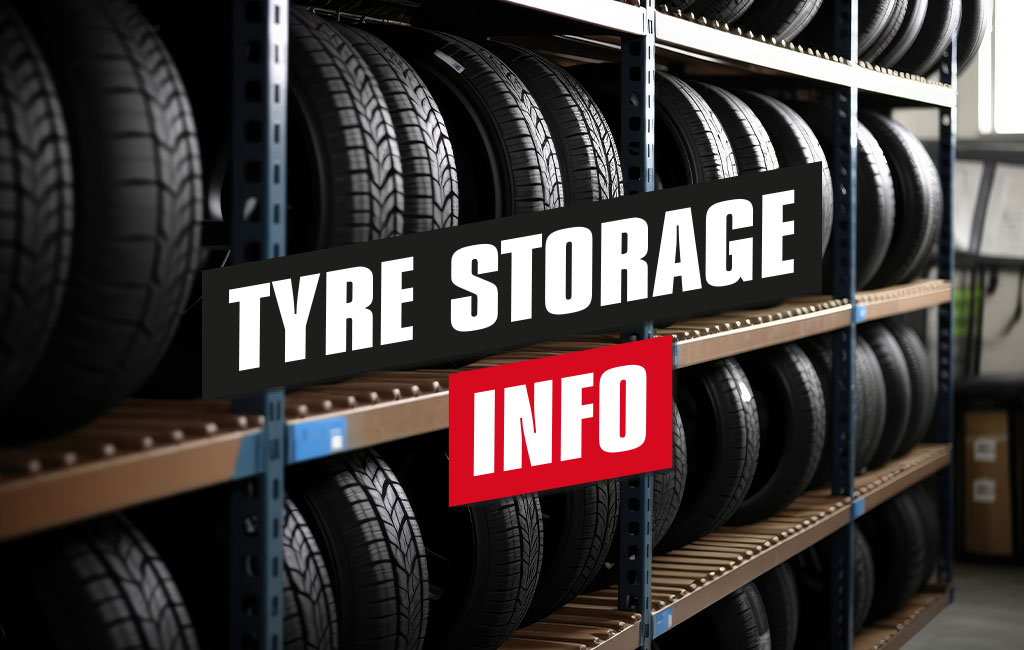
INFO: Tyre storage
Almost every car repair shop offers tyre storage for the respective off-season for a fee. So if you don't have a way to store your wheels at home, this service can be really worthwhile. And you won't have to worry about the right or wrong storage conditions.

